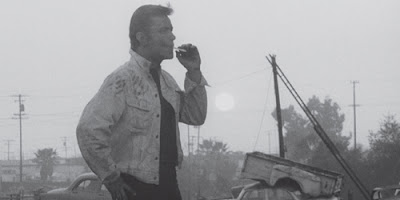Chuck Wepner was never my type of boxing hero. The underdog who gave Ali a pretty hard scrap and even scored a shitty knockdown before Ali beat the crap out of him, never really grabbed me. I didn't care about his self-deprecating wit, or his ability to bleed like he'd been shot in the face, or the fact that, as we've been reminded every day for forty years, he inspired Stallone to write Rocky. Of course, my failure to embrace this lovable loser is akin to sacrilege. Sports writers insist Wepner represents me, though I've always aimed higher than to be a liquor salesman who moonlights as a punching bag. No, I don't relate to Wepner at all. (I'm more the Riddick Bowe type, talented but inconsistent, and not as funny as I think I am.) So I didn't go into Chuck, which stars Liev Schreiber and is showing in scattered art cinemas before going direct to ePix or HBO2, with much enthusiasm. But I enjoyed it. Like a McDonald's burger, it didn't fool me into thinking it was high quality stuff, but it was OK. It filled the hole.
When we meet Wepner, he's in a ring that looks like it was probably once used for jello wrestling. He's squaring off with a bear for charity. Known as the toughest son of a bitch in Bayonne, New Jersey, Wepner usually enters his local pub to a round of applause, though he secretly fears what most people really think of him. Schreiber narrates as Wepner, and though some have compared this to Ray Liotta's voice-over in Goodfellas, it's too cutesy, too Rodney Dangerfield. Wepner is drafted to fight Ali because the champ hopes to generate publicity by facing a white guy. "I don't care if Ali's purple," says Wepner, which is as deep as the movie goes on the race topic. Because Chuck is set in the '70s, director Phillipe Falardou goes full Boogie Nights on us, with a disco soundtrack and a lot of fur coats. I've never equated Wepner with the sounds of Hot Chocolate, but the funky music gives the story a boost, like an ammonia capsule under the nose.
It's very much a standard sports bio, no better or worse than recent pics about Roberto Duran, Vinny Paz, and "Spaceman" Bill Lee. What we learn is that Stallone actually did Wepner a favor by depicting Rocky Balboa as a sort of heroic man-child. The real Wepner was a coke-snorting womanizer, and to the credit of Chuck, we see him not as some granite chinned, working class hero, but as a frail human. Elizabeth Moss plays Wepner's first wife, and she's brilliant when she tells one of Wepner's bimbos that ol' Chuck simply goes after any woman who smiles at him because, deep down, he feels like a stooge and needs approval. It's the best scene in the movie, and Moss is great, though Wepner ends up with a mouthy bartender played by Naomi Watts. (Schrieber's former wife, by the way.) As Linda Wepner, Watts is funny and has big hair, which is movie shorthand for Wepner living happily ever after.
Schreiber is a good actor, but he doesn't quite capture Wepner's essence. In dog terms, Wepner is a St. Bernard, Schreiber is a Doberman. But Schrieber also served as a producer on the movie, helped with the screenplay, and probably assisted with catering. This was a personal project for him, a labor of love many years in the making, and he turns in a solid, commendable performance. We believe him as a decent guy who was waylaid by his own hype - he's especially good in the scenes where Wepner hunts down Stallone and auditions for Rocky II - and fell from grace. Falardou even inserts snippets from Requiem for a Heavyweight, in case we're too dumb to get the message. Falardou, however, does a nice job mixing in vintage footage of fights and press conferences, which enhances the movie's feel for the era. Still, Chuck is hampered by two things: a self-conscious cuteness, and a surprising lack of energy. There are too many scenes of Wepner partying, and Wepner's prison hitch after being popped for cocaine possession doesn't amount to much in terms of drama. Finally, I was bothered by Schreiber's voice. He didn't really sound like the Wepner I've heard on old clips. I may have imagined it, but to me he sounded more like Stallone.





